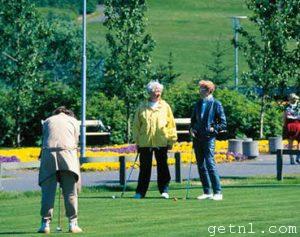
Frustrated by the lottery for the Old Course’s balloted tickets at St Andrews? Swap bracken, ferns, and heather for the glacial home of Reykjavík’s prestigious Icelandic PGA Open
NEED TO KNOW
LOCATION The Reykjavík Golf Club is based in Reykjavík, the capital of Iceland, in the North Atlantic Ocean close to the Arctic Circle LEVEL High and low handicappers
DAYTIME TEMPERATURES Jan: 32°F (0°C); Apr: 37°F (3°C); Jul: 54°F (12°C); Oct: 41°F (5°C)
St. Andrews in Scotland may have been synonymous with golf since the 15th century, but it might come as a surprise to learn that Iceland has twice as many golf courses per capita as Scotland – the so-called “home of golf.” Fifteen 18-hole courses are open to visiting players, together with almost 50 nine-hole facilities – that’s a staggering 700-plus holes and counting.
What’s more, unlike at St. Andrews, golf can be played round-the-clock in the summer months. Established in 1934, the RGC is the oldest and largest golf club in Iceland. It boasts two exceptional 18-hole courses, Grafarholt and Korpa, in an otherworldly landscape of volcanic crags, glaciers, gushing ravines, and rugged mountains.
The country’s awe-inspiring terrain features some of Mother Nature’s greatest triumphs, from tremendous ice caps and mammoth spouting geysers to gnarled lava chasms and cascading waterfalls. Just half an hour from the fairways, glacial lagoons and gin-clear sparkling pools beg exploration with deep-dives into an exhilarating underwater world. Summer golfers can enjoy 24-hour daylight from mid-June to mid-July each year, when Iceland’s midsummer “White Nights” encourage playing all night.
The 45-year-old Grafarholt layout is recognized as the nation’s premier championship venue. As the host of European and Nordic tournaments, Grafarholt is arguably the toughest test of golf in Iceland, with lava-hemmed fairways suited to big- hitters. However, the par-71, 6,590-yard (6,026-m) 18-hole course has more than rounded curves to contend with, as its stunning mist-shrouded panoramas over Reykjavík can prove to be a serious distraction.
Since it opened in 1997, the 18-hole Korpa has satisfied the golf-hungry with two distinct nines hugging the Atlantic coastline overlooking the Esja Mountain’s peaks. On the back nine, the par-4 12th and par-5 15th along the Korpa river’s banks require concentration. Designed by Iceland’s premier golf-course architect, Hannes Thorsteinsson, the par-72 course stretches for 6,600 yards (6,035 m), with innocuous looking holes inflicting the maximum punishment on high handicappers.
Acres of diabolical molten rock provide the rough from hell, though locals refer to this as vinur i hrauninu (a friend in the rocks) – as the phenomenon often sends wayward shots back into play when errant balls ricochet off the magma. The golf courses in Iceland peak in condition in mid-July to the end of August. Though the RGC’s courses attract many visitors, it would be a shame to miss out on some of the country’s other courses, some set in spectacular locations. You can even play a round by Vatnajökull, Europe’s largest glacier.
FORGET ST. ANDREWS?
THE BUILD-UP As the self-proclaimed “home of golf,” St. Andrews has welcomed golfers for more than six centuries. Though commonly referred to as a single course, St. Andrews is actually seven separate courses, each open to the public. You can follow in the footsteps of golfing legends, from Old Tom Morris and Bobby Jones, to Jack Nicklaus and Tiger Woods.
THE LETDOWN To walk the fairways of the Old Course at St. Andrews, golfers must enter a ballot for a chance to tee off the following day. Demand is high, with over 42,000 rounds played each year, so a prayer to the site’s religious relics by the West Bay are common as a last-ditch attempt in prompting a tee time.
GOING ANYWAY? Hand in a ballot card or call the ballot line by 2pm. Highly coveted tee times are hugely oversubscribed with inevitable disappointment for most. The good news is the New Course is usually offered as a consolation prize. The greens are much smaller than the Old but there are still plenty of deep sod bunkers to provide a decent test of golf.
PRACTICAL INFORMATION
Getting There and Around
Keflavik International Airport (Leifur Eiríksson International) lies on the Reykjanes Peninsula about a 40-minute drive southwest of Iceland’s capital Reykjavík. Taxis and airport bus shuttles, known as Flybus, connect the city center hotels with the terminal building.
Where to Eat
The art of preserving food is endemic to Icelandic culture, so it’s no surprise that pickles and cured and salted produce remain at the heart of local cuisine.
Classic dishes center on lamb, chicken, veal, and game.
However, fish is the mainstay in Reykjavík, such as at the Seafood Cellar
Where to Stay
As an alternative to the city’s bland, mainstream chain hotels, book a room at the ultra-stylish 101 Hotel, where 30 rooms and suites boast quirky one-off designs with a contemporary twist
When to Go
Iceland’s golf season runs for five months a year, peaking in summer when tee times are offered round-the-clock.
Budget per Day for Two
Allow US$280 to include accommodations, food, and green fees of US$40–55.
3 MORE GOLF COURSES TO RIVAL ST ANDREWS
ANTALYA PGA SULTAN COURSE, TURKEY Until recent years, nobody would ever have associated golf with Turkey. However, by 2008, Turkey’s Antalya PGA Sultan Course had hosted the PGA National Pro-Am Championship, Europe’s largest Pro-Am for the second year running.
ROYAL COUNTY DOWN, NORTHERN IRELAND Boasting a 100-year golfing tradition, this 18-hole facility with gorse- lined fairways that weave through tussock-faced bunkers is set in spellbinding scenery along Dundrum Bay’s shores. It is also one of US golfer Tiger Woods’ favorite courses.
LJUNGHUSEN GOLF CLUB, SWEDEN Jutting out into the Baltic Sea on the Falsterbo Peninsula, this 40-year-old club’s course sits within a protected marshland area. Its 27 holes are blasted by fearsome winds – little wonder several that heroic coastal holes have earned it a regular ranking in Sweden’s top five.